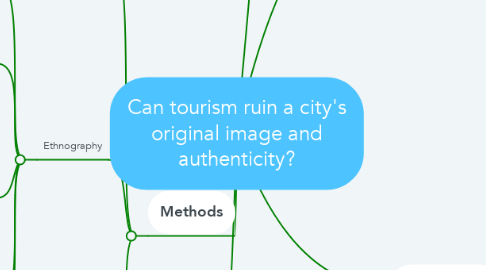
1. Semi structured walking interviews
1.1. Explore issues tourist inflict upon the city in regards to change of image - Longhurst, 2016
1.2. Anecdotes - combining the imagined with the real to explore associations and relationships - Micheal 2012
1.3. participant led
1.3.1. three people of different age groups
1.3.1.1. recorded and transcribed
1.4. based upon opinions
2. Image
2.1. 'Place Image' - a mental construct based upon impressions chosen from an individuals information of a place
2.1.1. Stylidis et al 2014
2.1.1.1. Residents place image is important for understanding their support for tourism, based upon their psychological involvement.
2.1.1.2. an individuals image of their place could be down to aspects such as scenery, architecture or nightlife
2.2. image is a dynamic concept that changes a the place evolves - Govers et al (2007)
2.3. Ramkissoon and Nunkoo 2011
2.3.1. Port Louis, Mauritius study
2.3.2. study into whether residents image of their own area influences their perceptions of the overall impact of tourism and consequent support for the industry
2.3.3. Rowles 1983 - concept of 'insideness'
2.3.3.1. help to gain perspective of an individuals psychological processes regarding place
2.4. Bath's image - quaint, peaceful, luscious, clean - has tourism changed this?
3. Methods
3.1. Qualitative data methods
3.2. Ethnography
3.2.1. Behaviour of tourist
3.2.2. senses
3.2.2.1. smell
3.2.2.2. touch
3.2.2.3. sound
3.2.2.4. sight
3.2.3. four locations
3.2.3.1. Pulteney Bridge
3.2.3.2. The Circus
3.2.3.3. Bath Abbey
3.2.3.4. The Roman Baths
3.2.4. An insight into the processes and meanings that motivate social groups - Herbert, 2000
3.2.5. creative
3.3. Photography
3.3.1. Place comparison
3.3.1.1. representation
3.3.1.2. Do tourist alter the image of the place?
3.3.2. Four tourist attractions
3.3.3. Used to highlight, feelings, experience, texture
3.3.3.1. a more-then-representational approach
3.3.3.2. Hunt, 2014
4. Authenticity
4.1. Besculides et al, 2002
4.1.1. argue authenticity has long been an issue in tourism
4.1.1.1. people visit an area to experience its unique culture, residents often actively attempt to present it in order to attract tourists
4.1.2. Hindu-Balinese case study
4.1.3. presenting a culture to tourists may dilute or destroy it
4.2. Britton, 1991
4.2.1. altering a place to generate tourism results in 'flatness'
4.2.2. appreciation of a place is being replaced by superficiality as a result of aiming for tourist satisfaction
4.3. Tourists are in search of authenticity, yet they require symbolic rather than objective - Wang 1999
5. Identity
5.1. Representations
5.2. Snaith and Haley 1998 York study
5.2.1. useful as another case study of a historical city with a tourism upholding much of their identity e.g. York Minister
5.3. 'Overtourism' - local people or tourists feel that the place is over visited and that is changing the character of the place
5.3.1. Taiminen 2018
5.3.1.1. ever growing tourism flows are posing a threat for many well know tourist destinations around the world
5.3.1.2. Locals feel their daily lives are being impacted by tourism
5.3.2. Goodwin, 2017
5.3.2.1. 'public goods' - places that cannot be charged for
5.3.2.2. overtourism has spoilt views and crowded streets
5.3.2.3. Barcelona - loss of identity

